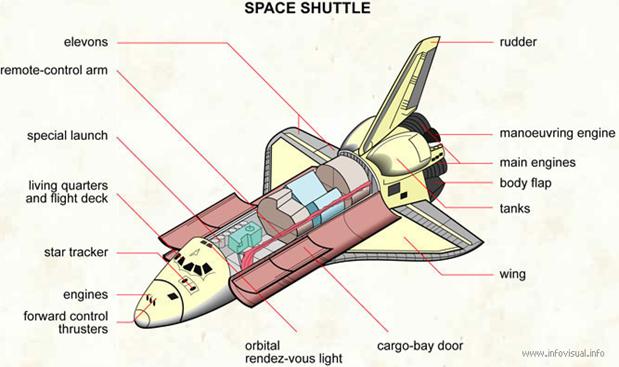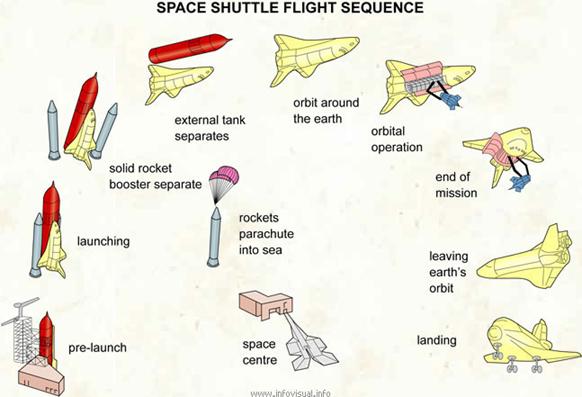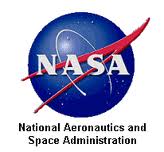Учебное пособие Астрономия. Космическая техника и технологии Алматы, 2012 удк 802. 0 52 629. 7 (0758) ббк 81. Англ. 923
 Скачать 1.02 Mb. Скачать 1.02 Mb.
|
|
True or False: Decide whether the following statements are true or false by referring to the information in the text. Then make the necessary changes so that the false statements, become true. 1) A bullet is faster than a rocket taking off. 2) If you shoot a bullet straight up it will go higher than Everest. 3) Jet engines don't work at 11,000 metres. 4) The air is too thin to breathe at 11,000 metres. 5) A rocket accelerates more as it goes up. 6) When something starts to fall it decelerates. 7) There are usually problems during the countdown for the launch of a rocket. 8) The sky is black in space. 9) Jules Verne calculated the speed of the cannonball in his story correctly. 10) Rocket engines are very quiet. Text 9C Space Shuttle The space shuttle was made to take astronauts and cargo to and from Earth orbit. The first space shuttle flight took place in 1981. NASA stopped flying the shuttle in 2011. The space shuttle normally takes as many as seven astronauts to and from space. The space shuttle has done many kinds of jobs. It has launched satellites from its cargo bay. It had been a science laboratory while orbiting Earth. Its crews had fixed other spacecraft, such as the Hubble Space Telescope. The space shuttle used to work on the International Space Station. The space shuttle has three main parts. The first part is the orbiter. The orbiter is the large, white space plane. It is the only part of the shuttle that goes into orbit. The orbiter is where the crew members live and work. It also has a payload bay for taking cargo into orbit. The second part of the shuttle is the external tank. This large, orange fuel tank connects to the bottom of the orbiter for launch. The third part is really two pieces. Two white solid rocket boosters send out most of the thrust for the first two minutes of a shuttle launch. The solid rocket boosters are long and thin. The space shuttle takes off like a rocket. The solid rocket boosters and the main engines on the orbiter provide the thrust for launch. The solid rocket boosters burn for about two minutes. Then they are dropped from the shuttle and fall into the ocean. Special boats bring them back so they can be used again. The shuttle’s main engines fire for about another six minutes. The external tank is dropped when all the fuel has been used. Shortly after this happens the shuttle and crew are in orbit. The orbiter lands like a glider. While in orbit it fires its engines to slow down and stop orbiting. After it re-enters Earth's atmosphere, it glides in for a landing on a runway. Space Shuttle Space shuttle is reusable space vehicle used for travel between a space station and Earth. Look at the picture and complete the table: 
Space Shuttle Flight Sequence Look at the scheme of space shuttle flight sequence (order of the different operations of the flight) and match each stage with definition: 
Space Shuttle Quiz At its best, the space shuttle is the embodiment of 20th-century scientific progress, a stunningly complex vehicle that can lift into space, orbit the Earth, return to Earth's atmosphere, and be re-used in a matter of weeks. At its worst, the shuttle is a symbol of the dangers that come with space travel. How did the shuttle program begin? And what keeps astronauts alive in the depths of outer space? Choose the correct answer: 1) How long does a typical space shuttle mission last? a) seven to eight days b) about three weeks c) between two and three months 2) What percentage of the thrust necessary to lift a space shuttle do the solid rocket boosters (SRBs) provide? a) 50 percent b) 71 percent c) 100 percent 3) The main engine's external fuel tank primarily contains: a) liquid oxygen b) liquid hydrogen c) liquid nitrogen 4) Which of the following is not a reason the external fuel tank is covered with a special, inch-thick layer of foam insulation? a) to keep the fuel cold b) to minimize ice formation c) to stabilize the tank so that it doesn't dislodge after ignition 5) Which of the following occurs at T plus 8.5 minutes of a typical shuttle launch? a) the shuttle engines are at maximum throttle b) the external fuel tank separates from the orbiter c) the main engines shut down 6) What part of the shuttle orbiter contains the main engines? a) the aft fuselage b) the forward fuselage c) the forward RCS module 7) Which of the following best describes the communication system between Mission Control and the shuttle orbiter? a) Mission Control sends a signal directly to the shuttle, using the S-band system for audio. b) A signal is sent to a radio antenna, which relays the signal to satellites, and then on to the shuttle. c) Mission Control sends a signal to a station in California, which sends a signal directly to the shuttle. 8) Why does NASA place more than 100 cameras around the launch pad to film the shuttle during liftoff? a) They record the liftoff in an effort to detect possible debris or damage to the shuttle that occurred. b) They record the liftoff from different angles so that they have footage for the official documentary. c) They record the liftoff to ensure that experiments on the exterior of the orbiter occur without incident. 9) What U.S. president announced the development of the space shuttle? a) John F. Kennedy b) Lyndon B. Johnson c) Richard M. Nixon 10) Which space shuttle made the first flight in 1981, piloted by astronauts John Young and Robert Crippen? a) Columbia b) Challenger c) Discovery Unit 10 NASA T  ext 10A ext 10ANASA The National Aeronautics and Space Administration (NASA) was established on October 1, 1958, a year after the USSR sent Sputnik, the first earth satellite, into space. In 1961, after Soviet cosmonaut Yuri Gagarin became the first man in space, the new agency was assigned responsibility for meeting President Kennedy's commitment to put a man on the Moon by the end of the 1960s. Accomplishing the goal under this strict time constraint was an enormous challenge. By 1966, the 10,000 people employed at the space agency in 1960 had grown to 36,000. NASA's annual budget increased from $500 million in 1960 to a high point of $5.2 billion in 1965, 5.3 percent of the federal budget for that year. Approximately 50 percent of that amount went directly for human spaceflight; the vast majority of that went directly toward Apollo. The project eventually cost $24 billion. According to John Noble Wilford, space correspondent for the New York Times, Apollo was the "greatest mobilization of men and resources ever undertaken for a peaceful project of science and exploration."№ When NASA began operations in October of 1958, it absorbed into it the earlier National Advisory Committee for Aeronautics intact; it’s 8,000 employees, an annual budget of $100 million, three major research laboratories--Langley Aeronautical Laboratory, Ames Aeronautical Laboratory, and Lewis Flight Propulsion Laboratory--and two smaller test facilities. It quickly incorporated other organizations into the new agency, notably the space science group of the Naval Research Laboratory in Maryland, the Jet Propulsion Laboratory managed by the California Institute of Technology for the Army, and the Army Ballistic Missile Agency in Huntsville, Alabama. With the advent of Apollo, the Jet Propulsion Laboratory took over responsibility for developing the necessary guidance and communications technologies and for learning more about the lunar environment. The Marshall Space Flight Center was formed around the Army's ballistic missile team at Redstone Arsenal, which was led by Dr. Wernher von Braun and the other engineers who had developed the first successful rocket, the German V-2. Marshall was responsible for building and testing the rockets to power the spacecraft. NASA created three new facilities specifically to meet the demands of the lunar landing program. In 1962 the agency built the Manned Spacecraft Center (renamed the Lyndon B. Johnson Space Center in 1973), near Houston, Texas, to design the Apollo spacecraft and the launch platform for the lunar lander. This center also became the home of NASA's astronauts and the site of mission control. The scientists and engineers in the control room monitored all the details of the moon flight once the rocket was launched. The Launch Operations Center (renamed the John F. Kennedy Space Center in 1963) at Cape Canaveral on Florida's eastern seacoast was greatly enlarged. All of the Saturn/Apollo rockets were assembled in Kennedy's huge 36-story Vehicle Assembly Building and fired from Launch Complex 39. Finally, in October 1961, NASA created the Mississippi Test Facility, renamed the John C. Stennis Space Center in 1988. It was here that the Saturn rockets were tested. The cost of this expansion was great, more than $2.2 billion over the decade. NASA's leaders made an early decision to rely upon outside researchers and technicians to complete the Apollo project. Between 80 and 90 percent of NASA's overall budget in the 1960s went for contracts to purchase goods and services from private industry, research institutions, and universities. Contractor employees working on the program increased more than 10 times, from 36,500 in 1960 to 376,700 in 1965. NASA found that this was both good politics and the best way of getting Apollo done on time. It was also very nearly the only way to harness talent and institutional resources already in existence in the emerging aerospace industry and the country's leading research universities. More than 500 contractors worked on both large and small aspects of Apollo. For example, the Boeing Company was the prime contractor for the first stage of the Saturn rocket, North American Aviation for the second stage, and the Douglas Aircraft Corporation for the third stage. The Rocket dyne Division of North American Aviation was responsible for the rocket engines and International Business Machines for the instruments. These prime contractors, with more than 250 subcontractors, provided millions of parts and components for use in the Saturn launch vehicle, all meeting exacting specifications for performance and reliability. Getting all of these people to work together challenged the men and women responsible for managing the program, whether they worked for the Federal Government, a private industry, or a university. According to Dr. Leonard R. Sayles and Dr. Margaret K. Chandler of the Graduate School of Business at Columbia University, NASA's most significant contribution was "getting an organizationally complex structure, involving a great variety of people doing a great variety of things in many separate locations, to do what you want, when you want it--and while the decision regarding the best route to your objective is still in the process of being made by you and your collaborators." Answer the questions: 1) What event led to the creation of NASA? What event contributed to the decision to send an American to the Moon by the end of the 1960s? 2) What evidence indicates that the Cold War affected the American space program? Why do you think the program was sometimes called "the space race?" 3) How many different kinds of work and workers can you identify from this reading? 4) Why was the work for the Apollo program spread out over so many sites? What do you think the advantages and disadvantages might have been if it had been concentrated in one place? Discuss. 5) Why did the project rely so heavily on private industry, research institutions, and universities? What advantages and disadvantages do you think this might have had over using government employees exclusively? Listening “America's Space Agency Turns 50” Listen to American radio program and match dates and events:
|
